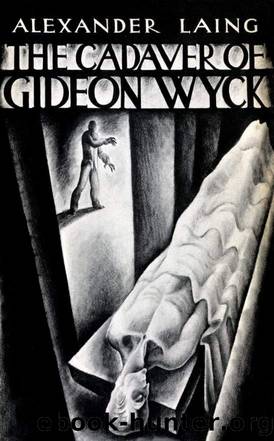The Cadaver of Gideon Wyck: By a Medical Student by Alexander Laing & William Hjortsberg & Lynd Ward

Author:Alexander Laing & William Hjortsberg & Lynd Ward [Alexander Laing & William Hjortsberg & Lynd Ward]
Language: eng
Format: epub
Tags: Fiction, Horror, Sci-Fi, Mystery, Valancourt, Classics
ISBN: 9781933618364
Google: I7vTNAAACAAJ
Goodreads: 7685386
Publisher: Centipede Press
Published: 1934-01-01T00:00:00+00:00
Nineteen
To my vast relief, the jurors were filing out. Dr. Kent said, âMr. Saunders, Dr. Alling requested that I permit you to make a copy of the post-mortem findings. As it will be filed in the town records, where any citizen can inspect it, I see no reason for opposing the request.â
I set to work, under the eye of the sheriff, and made the following transcript:[1]
POST-MORTEM EXAMINATION, of the body of Gideon Wyck, M.D., Ã 66/67 years, found dead and embalmed in vault of the Maine State College of Surgery, on Sept. 2, 1932.
External Peculiarities. 1. An incision in the region of the left groin, leading to the femoral artery. (Made presumably to inject embalming fluid.)
2. An ante-mortem puncture wound in the suboccipital region, penetrating the space between the first and second cervical vertebrae, and transecting the spinal cord at this juncture. This wound was presumably inflicted by means of a sharp, scalpel-like instrument in the hands of a person with knowledge of anatomy.
3. A group of six minute scars in the left anticubital fossa.
4. An ancient scar, ten centimeters in length, in the lower right rectus region of the abdominal wall.
Internal Peculiarities. 1. A carcinomatous growth of medium malignancy at the neck of the bladder, capable of causing death within a year.
2. Early carcinomatous metastasis to the bones of the skull.
3. Evidence of pronounced internal hemorrhage in skull cavity and spinal cord.
4. An atrophic and scarred area underlying the rectus scar, with adhesions to the peritoneum but outside the peritoneal cavity.
Chemical Analyses. 1. Analysis of stomach and intestinal contents demonstrates presence of approximately 8 grams of diethylbarbaturic acid (veronal), enough to have caused death when absorbed.
2. Analysis of other organs shows the presence of the above drug and leads to the presumption of a general distribution of the drug, the quantity probably under 4 grams. Enough to indicate possible chronic poisoning. Probably not enough to have caused death.
Cause of Death. Transection of the spinal cord in the region of the first cervical segment, due to a wound inflicted by a sharp instrument. The nature and position of the wound indicate homicide. The other circumstances lend a strong presumption of truth to the idea that the fatal incision was inflicted while the victim was unconscious from the action of the poison.
Time of Death. Due to the time elapsed, and to the fact that embalming must have occurred within four hours after death, no time of death can be determined by anatomical inspection.
Signed,
HATHAWAY KENT, M.D.
Coroner, Alton County.
Witnesses:
Eliphalet Smith, M.D.
J. B. Otis
Download
This site does not store any files on its server. We only index and link to content provided by other sites. Please contact the content providers to delete copyright contents if any and email us, we'll remove relevant links or contents immediately.
11/22/63 by Stephen King(2927)
11/22/63: A Novel by Stephen King(2898)
Slow Horses by Mick Herron(2833)
The Haunting of Hill House by Shirley Jackson(2401)
Pet Sematary by Stephen King(2380)
If It Bleeds by Stephen King;(2366)
Real Tigers by Mick Herron(2251)
Home Before Dark by Riley Sager(2157)
Misery by Stephen King(2133)
If It Bleeds by Stephen King(2033)
The Sun Down Motel by Simone St. James(1926)
Different Seasons by Stephen King(1884)
Backfire by Catherine Coulter(1716)
Devoted by Dean Koontz(1713)
Doctor Sleep: A Novel by Stephen King(1641)
Anna Dressed in Blood by Kendare Blake(1641)
Penpal by Auerbach Dathan(1462)
The Ruins by Scott Smith(1451)
Cujo by Stephen King(1433)
